Edie Melson's Blog, page 81
August 2, 2023
5 Ways Crochet Can Help us Persevere in Our Writing Endeavors
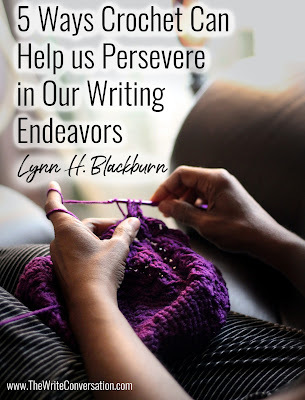
by Lynn H. Blackburn @LynnHBlackburn
When I’m not writing or reading, I like to knit and crochet. I usually focus on small projects that I can complete in a few hours. They give me that little “I finished it” thrill which is in short supply in my one-book-a-year writing life.
A few weeks ago, I had the *joy* of experiencing significant flight delays that left me chilling in the airport with time on my hands. I pulled out my crochet project and whipped up a few little coasters in a colorway that I find soothing.
And of course, because I can relate anything to writing, I started thinking about the similarities between my favorite creative pursuits.
It turns out that there’s a lot to learn from the things I have no problem with when it comes to crochet but that I struggle with in my writing life.
5 Things Crochet Can Remind Me About Writing
1. If I don’t pick up a hook for a while, I forget how to make even the most basic stitches.
I have to bust out some YouTube videos or online instructions to remind myself how to do what I claim I know how to do. But when I crochet daily, even if it’s just for a few minutes, it’s like my hands just know what to do, and they do it.
Same with writing. I may (cough, cough) know a writer who has had a lot on her plate/mind/heart for the past few months and recently had to look up her hero’s last name. Because…she forgot. She’d been away from her manuscript for too long. Way too long.
This particular writer has been through this before. And she knows that once she starts writing again, the words will flow. Her hands and mind and heart will sync, and she’ll be able to create a story. But when she has to start over after a long time away? It hurts.
Because she knows it hurts, she puts it off. Which just means it will hurt worse to start. When she finally gets back to it, she spends several days remembering how to do something she claims to know how to do.
There’s a lesson here about not taking long breaks, but that’s too convicting so I’m not going to bring it up.
2. Even when you follow a pattern, the end result will be uniquely yours.
Why is this? Well, every crocheter has their own way of holding the yarn and hook. Some crochet tight. Some loose. Some will choose to follow the pattern but use a larger hook or a thinner yarn. And each artist will choose the yarn that they find most appealing.
Same with writing. You could hand twenty different writers the same basic story idea and you would get twenty different versions. You’d get poetry, historical, fantasy, and romance. Some would be short, some long. All would be unique to their author.
Every writer brings their own life experiences, opinions, dreams, and style to every story. That’s why there’s always room for a new storyteller to join our ranks.
3. Sometimes you have to start over.
There are many reasons for this. For me it’s usually because I forgot to count, and I’ve added/dropped stitches and the square I was trying to make is now a trapezoid. Sometimes it’s because I think I’m doing it right and then realize I took a wrong turn with the instructions and there’s no saving it. It’s painful to unravel all that work, but I chalk it up to a learning experience and start again.
Same with writing. For me, writing the first few chapters of any story is as headache inducing as going without coffee. #donotrecommend
One thing that has helped me is to realize that when I have to start over or cut huge portions of work to send the story in a different direction, that the time wasn’t wasted. I learned about my characters, and I figured out what not to do. It’s painful, but the sooner I accept it and do what must be done, the better.
4. Over time, you might decide to try something new.
I started my needlework journey with cross stitch when I was very young. I learned to knit when I was a new mom. And then a few years ago I tried my hand at crochet. I haven’t cross stitched in years. These days I mostly knit and crochet.
Same with writing. You might start out writing poetry and then one day decide to have a go at a memoir. You might be writing nonfiction and then one day realize there’s an urban fantasy story brewing in your brain. Maybe you’re a romance author who tackles a Bible study.
There’s no limit, writer friends! Your creativity will expand and refocus over the years. The beautiful thing is that you can choose to explore any or all of it whenever you want.
Because…
5. The true joy of crochet is in the process, not the finished product.
Don’t get me wrong, I like to finish projects! But mostly, I enjoy exploring new stitches and having something soft and beautiful in my hands.
Same with writing. I know. I know. The publishing journey focuses on the finished product. I get it. I’m on a deadline myself.
But sometimes, I write for no reason other than that I enjoy it. When I do, I remember that I actually love to write! I love shaping the words and watching something beautiful develop as I return to the keyboard again and again.
Do you have a favorite hobby that has taught you about writing? I’d love to hear your story!
Grace and peace,Lynn
TWEETABLE5 Ways Crochet Can Help us Persevere in Our Writing Endeavors from author @LynnHBlackburn on @EdieMelson (Click to Tweet)
 Lynn H. Blackburn loves writing romantic suspense because her childhood fantasy was to become a spy, but her grown-up reality is that she's a huge chicken and would have been caught on her first mission. She prefers to live vicariously through her characters and loves putting them into all kinds of terrifying situations while she's sitting at home safe and sound in her pajamas!
Lynn H. Blackburn loves writing romantic suspense because her childhood fantasy was to become a spy, but her grown-up reality is that she's a huge chicken and would have been caught on her first mission. She prefers to live vicariously through her characters and loves putting them into all kinds of terrifying situations while she's sitting at home safe and sound in her pajamas! Unknown Threat, the first book in her Defend and Protect series, was a 2021 Christy Award finalist and her previous titles have won the Carol Award, the Selah Award, and the Faith, Hope, and Love Reader’s Choice Award. Malicious Intent, the second book in the series, released March 2022.
She is a frequent conference speaker and has taught writers all over the country. Lynn lives in South Carolina with her true love and their three children. You can follow her real life happily ever after by signing up for her newsletter at LYNNHBLACKBURN.COMand @LynnHBlackburn on BOOKBUB, FACEBOOK, TWITTER, PINTEREST, and INSTAGRAM.
Featured Image: Photo by Imani on Unsplash
Published on August 02, 2023 22:00
August 1, 2023
7 Steps in Writing the Heroes Journey
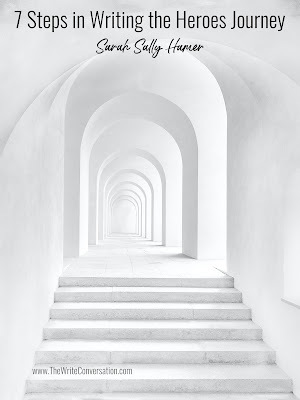
by Sarah Sally Hamer @SarahSallyHamer
Because I’m a writer and teacher of writing, I became acquainted with Joseph Campbell’s version of The Hero’s Journey decades ago. Its basic structure, one of an understanding of the journeys we all take during our lifetime, is also the basis of almost every story told, no matter when, who, or where in the world it was told. Every continent, every culture, every era since humans began to tell stories—probably before and after hunts where they danced around a campfire—have the same structure. (NOTE: I use Hero and Heroine interchangeably.)
Of course, writing stories isn’t the only use of The Hero’s Journey. It actually is the foundation of how our lives work. We follow the same path as do the heroes and heroines we read about or watch on a TV screen. Our video games are wrapped around a journey that includes times of great adventure, great despair, and great courage. In our “real” life, we have questions to answer, conundrums to solve, villains and dragons to slay, and a time of not knowing what to do next. But we persevere, we determined humans, and we create a better place for us, our families, our world. This is The Heroine’s Journey.
This Journey has many stops along the way. We’re going to concentrate on seven steps, although different people use different numbers, because I like to keep it simple.
7 Steps for Writing the Heroes Journey
1. Ordinary World
We all start somewhere. Our Ordinary World is a culmination of everything that has happened to us up to this point. It’s our point of view, our worldview, our story—all the things that meld together to make us the “I am”. What do you believe? What do you think? Why do you make the decisions you do? How do you react to various situations? In other words, who are you, exactly?
2. Initial Understanding
What is your “Need to Change” Pattern? What is currently going on in your life? Do you see something you’re not happy with? Why? What frequency are you holding? Is it working for you? This is the place where Dorothy in The Wizard of Ozsings her song about where she could be happy, if she was just on the other side of the rainbow. Are you happy where you are or should you change something to find that sweet spot?
3. Recognition of the need to change something in your life.
Other people can see the “real” you, often better than you yourself can. We attract these people into our lives to show us what isn’t going well and what needs to be examined and changed. Look around you. What do you see? Are you in a healthy, happy relationship with your family, friends, work, and people you casually come into contact with? Or do you find yourself constantly in turmoil and unhappiness? This is what you’re reflecting on the world, based on who you actually are inside. The mask must come off and the reality of who you are must be revealed.
4. Revealing the Hidden
Reveal the truth of who you are. The lies, the terrors, the goblins within are old survival habits. Although our society demands that we control our worst instincts, we often are forced into being something we’re not. We’re told who we are—given labels—by the people who surround us from birth: You’re so dumb! You know better! Don’t slam the door! Girls can’t do math. Boys can’t cry. So, that’s who we become, a conglomerate of the ideas of who we should be according to our parents, siblings, teachers, friends. By opening the door to our inner selves, we are given the chance to see what we can do to truly “Know Thyself” as is written above the door into the Delphi Temple in Greece, and become the person we deserve to be.
5. We are Divinely Supported
Spirit, Divine, God—whatever the term you decide to use—is available and willing to help you. You only need ask.
6. The Battle for Our Self
Now, we make choices. Do we truly want to change? When does the pain become greater than the fear? Can we step forward and truly become what we deserve to be?
7. Winning the Battle
We have gone through the layers of the journey, discovering the obstacles that have held us back. Now, with the bright light of day shining on our old fears, we can create new and wonderful patterns and new paths to happiness, health, success, and peace of mind.
Yes, this is the pattern in almost every story you’ve ever been told. Since the journey is based on humans, it’s a completely human experience.
What is your experience? Is it truly yours or is it something you’ve been told is yours?
Who are you?
TWEETABLE7 Steps in Writing the Heroes Journey with @SarahSallyHamer on @EdieMelson (Click to Tweet)
 Sarah (Sally) Hamer, B.S., MLA, is a lover of books, a teacher of writers, and a believer in a good story. Most of all, she is eternally fascinated by people and how they 'tick'. She’s passionate about helping people tell their own stories, whether through fiction or through memoir. Writing in many genres—mystery, science fiction, fantasy, romance, medieval history, non-fiction—she has won awards at both local and national levels, including two Golden Heart finals.
Sarah (Sally) Hamer, B.S., MLA, is a lover of books, a teacher of writers, and a believer in a good story. Most of all, she is eternally fascinated by people and how they 'tick'. She’s passionate about helping people tell their own stories, whether through fiction or through memoir. Writing in many genres—mystery, science fiction, fantasy, romance, medieval history, non-fiction—she has won awards at both local and national levels, including two Golden Heart finals.A teacher of memoir, beginning and advanced creative fiction writing, and screenwriting at Louisiana State University in Shreveport for over twenty years, she also teaches online for Margie Lawson at WWW.MARGIELAWSON.COM. Sally is a free-lance editor and book coach at Touch Not the Cat Books, with many of her students and clients becoming successful, award-winning authors. You can find her at HAMERSE@BELLSOUTH.NET or WWW.SALLYHAMER.BLOGSPOT.COM
Featured Image: Photo by Robin Schreiner on Unsplash
Published on August 01, 2023 22:00
July 31, 2023
Tips for Writers: When Talking Is Showing, Not Telling
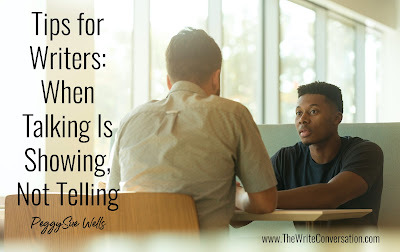
by PeggySue Wells @PeggySueWells
For a writer, dialog is a handy tool to show, instead of tell your reader important information about your character.
The vocabulary of a character lets the reader know if the character is educated, gives clues to the region the character is from, and shows the character’s nature to be relaxed, tightly wound, worried, sly, or confident.
Reading this excerpt from Chasing Sunrise, the speaker’s dialect instantly connects him to his background on St. Croix.
A nearby local answered Bryce’s question. “We go to the crab races, mon.”
Bryce and Michael looked over at the eavesdropper, who was keeping pace on his way to somewhere.
“Crab races?” Bryce echoed.
“You’re new to the island.” With brown eyes and an easy smile, the medium-built man stuck out his hand to Bryce and Michael. “I’m Ned. Native to the island.”
At the end of the story, Ned appears in a completely different setting, but he remains the man from the island.
“Ya’ good, mon?” His dark eyes reflecting kind reassurance, Brother Ned stressed the accent as he dropped a reassuring hand on Michael’s shoulder.
Similarly, readers get to know the character and personality of Corbin McIntyre through the words he uses.
There was a long silence while Michael and Corbin regarded one another. At last the CO nodded. “A fair offer is nae cause fur feud.” Corbin stood and extended his hand to Michael. “We have an accord.”
Corbin’s unique vocabulary commonly shows up in his everyday dealings with his team.
Corbin covered the phone with his hand. “Jings and crivvens, Michael. Shut up and sit down.”
Later in the novel, we see Corbin when his temper is up.
“The Scottish people have a saying, Mr. Northington.”
Braced for the verbal onslaught, Michael maintained strict military bearing.
“God takes care of the poor and the stupid.” Corbin pushed his face close to Michael’s and thrust his finger into Michael’s chest, emphasizing every word with a thump against his breastbone. “And you, Mister, are the visual aid for the latter.”
Dialog can show a character’s personality. Bryce Lassiter, the sidekick in Chasing Sunrise is known for remaining calm. Bryce’s easy-going personality is reflected in his pattern of droppin’ the g at the end of words ending in ing.
Bryce caught up. “Where we goin,’ partner?”
When our hero is at a crossroads, Bryce is the steady presence.
Bryce took in the scattered newspaper with several items circled in blue ink and Michael’s empty glass. “Since I’m the only one here still employed, I’ll do the buyin’. What’s your brew?”
Bryce lends a casual air even in the midst of tension.
Bryce peered through the scope. “Somethin’s not right.”
A conversation tag is another tool to add depth to the personality of a character. In Riven by Jerry B. Jenkins, the prison warden commonly answers questions with, “Yanno,” a run together of “Yeah, no.” Yeah, I heard you and no is the reply.
Introverted Matthew Cuthbert, in the Anne of Green Gables feature film answers Anne’s many questions with a phrase that gives him a beat to think. “Well, now,” he draws out as he collects his thoughts.
Additionally, to keep the story in flow, common filler words are removed from conversation in the editing process. YeahOkayHelloGood-byeOhWell
The exception is when a filler word is used to spotlight a personality trait such as Matthew Cuthbert’s “Well now …”
In the first draft, dialog may begin with “Hello,” “Oh,” “Well,” or “Yeah,” and end with ‘Good-bye,” but in the editing process, remove these unnecessary distractions that interrupt the flow and pull the reader out of the story.
How can you use dialog to show, instead of tell, your reader vital information about the personality and background of your character?
TWEETABLETips for Writers: When Talking Is Showing, Not Telling from author @PeggySueWells on @EdieMelson (Click to Tweet)
Don't Miss the Other Posts in This Series
WRITING DIALOG WORTH QUOTING
DIALOGUE OR DIALOG
HOW TO KEEP THE DIALOG YOU WRITE FRESH
WHAT TO LEAVE OUT OF THE DIALOG YOU WRITE
TIPS FOR WRITERS: WHEN TALKING IS SHOWING, NOT TELLING
 Tropical island votary and history buff, PeggySue Wells parasails, skydives, snorkels, scuba dives, and has taken (but not passed) pilot training. Writing from the 100-Acre Wood in Indiana, Wells is the bestselling author of thirty books including The Slave Across the Street, Slavery in the Land of the Free, Bonding With Your Child Through Boundaries, Homeless for the Holidays, Chasing Sunrise, and The Ten Best Decisions A Single Mom Can Make. Founder of SingleMomCircle.com, PeggySue is named for the Buddy Holly song with the great drumbeat. At school author visits, she teaches students the secrets to writing and speaks at events and conferences. Connect with her at www.PeggySueWells.com, on Facebook at PeggySue Wells, and LinkedIn at linkedin.com/in/peggysuewells
Tropical island votary and history buff, PeggySue Wells parasails, skydives, snorkels, scuba dives, and has taken (but not passed) pilot training. Writing from the 100-Acre Wood in Indiana, Wells is the bestselling author of thirty books including The Slave Across the Street, Slavery in the Land of the Free, Bonding With Your Child Through Boundaries, Homeless for the Holidays, Chasing Sunrise, and The Ten Best Decisions A Single Mom Can Make. Founder of SingleMomCircle.com, PeggySue is named for the Buddy Holly song with the great drumbeat. At school author visits, she teaches students the secrets to writing and speaks at events and conferences. Connect with her at www.PeggySueWells.com, on Facebook at PeggySue Wells, and LinkedIn at linkedin.com/in/peggysuewells
Published on July 31, 2023 22:00
July 30, 2023
Why Writers Should LOVE the Back-to-School Season
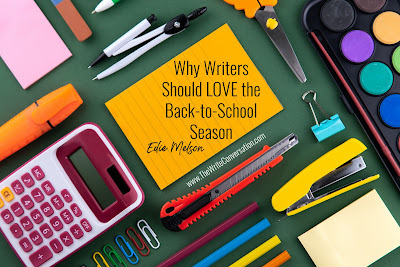
by Edie Melson @EdieMelson
I have a confession to make. Growing up, back-to-school was one of my favorite times of the year. It wasn’t that I loved school so much (but I didn’t hate it, but I had the normal school year angst that most kids struggle with). But the promise of new school supplies outweighed any negativity for me. Even now, I just love buying school supplies.
There’s just something about new pencils, pens, erasers, paper, and notebooks that make heart happy. And don’t get me started about all the amazing notebooks, pouches and organizational stuff every writer (student) needs!
This obsession might have gotten me banned from going back-to-school shopping for my kids without my husband—or another responsible adult—with me.
8 Things This Writer Loves About Back-to-School ShoppingThe sales on writer . . . uh . . . school supplies. There’s just something about new pencils, pens, erasers, paper, and notebooks that make heart happy. And don’t get me started about all the amazing notebooks, pouches and organizational stuff every writer needs.The fact that I can go into a store and stock up on these supplies without looking like I have a problem. (Hi, my name is Edie and I love to buy office supplies in bulk.)Watching others who love writing supplies as much as me. I enjoy visiting the back-to-school aisles at stores and people watch. Most kids are less than thrilled with the process, but every time I go, I see future writers who just love to get new supplies. Getting ideas for new things to organize my writing life. Office supply manufacturers are always coming up with new ideas. I love browsing the aisles stocked with ideas for organizing lockers, as well as ways to keep track of ideas and schedules. My latest obsession, though? Transparent sticky notes. A perfect excuse to buy a new bag. My backpack/computer bag obsession might be even bigger than my school supply one. New crayons. Enough said.It’s a mini-restart in the middle of my writing year. I’m not a fan of summer. The heat and lack of a regular schedule suck the writing inspiration right out of my soul. Even though the back-to-school season seems to come earlier and earlier every year, it’s still the promise of a return to cooler weather, disciplined routine, and fresh inspiration. The new color schemes and patterns. I do love basic school supplies. A number 2 pencil and yellow legal pad are the stuff of my teenage writing years. But I’m also a sucker for new colors in binder clips, notebooks, and magnets.Tax-free weekends. In our part of the united states, our state and several others close by have a tax-free weekend to help with the expense of back to school. This means everything from computers to crayons can be purchased without paying sales tax.These are some of the things that bring me joy during the back-to-school season. What are some of your favorite things about this time of year? Be sure to leave your thoughts in the comments section below.
Don’t forget to join the conversation!Blessings, Edie
TWEETABLE
Why Writers Should LOVE the Back-to-School Season from @EdieMelson (Click to Tweet)
 Edie Melson is a woman of faith with ink-stained fingers observing life through her camera lens. She’s a writer who feels lost without that device & an unexpected speaker who loves to encourage an audience. She also embraces the ultimate contradiction of being an organized creative. She knows the necessity of Soul Care and leads retreats, conferences & workshops around the world on staying connected to God. Her numerous books, including the award-winning Soul Cares eries & reflect her passion to help others develop the strength of their God-given gifts. Her blog, The Write Conversation is recognized as one of the top 101 industry resources.
Edie Melson is a woman of faith with ink-stained fingers observing life through her camera lens. She’s a writer who feels lost without that device & an unexpected speaker who loves to encourage an audience. She also embraces the ultimate contradiction of being an organized creative. She knows the necessity of Soul Care and leads retreats, conferences & workshops around the world on staying connected to God. Her numerous books, including the award-winning Soul Cares eries & reflect her passion to help others develop the strength of their God-given gifts. Her blog, The Write Conversation is recognized as one of the top 101 industry resources. She and husband Kirk have been married 40+ years and raised three sons. They live in the foothills of the Blue Ridge Mountains and can often be found hiking—with Edie clinging to the edge of a precipice for the perfect camera angle and Kirk patiently carrying her camera bag and tripod. Connect with her on her website, WWW.EDIEMELSON.COM and through social media.
Featured Image: Photo by Volodymyr Hryshchenko on Unsplash
Published on July 30, 2023 22:00
July 29, 2023
How to Hold On To Hope When Your Publication Date is Delayed
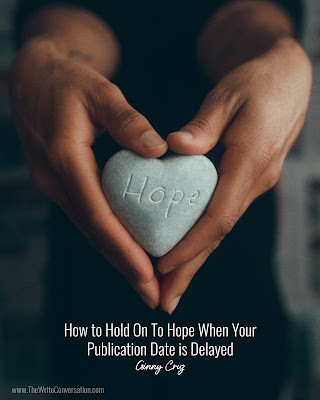
by Ginny Cruz, MPA, PT
Have you ever completed a writing project only to have its publication date delayed? You may have finished a book and can't find a publisher. Or, you have a desk stacked high with devotions or inspirational short stories, but God has not given you clarity on what to do with them.
The Call
Years ago, when God called me to write, the road ahead wasn't a road at all. It was more like a fog-enshrouded trail. There was barely enough light to see the next step. I asked God, “Should I write for children or adults? Silence. “Should I write fiction or non-fiction?” Nothing.
Not knowing what my next step should be, I wrote what felt right. Some of those works found an audience, and others did not. But I completed each one. And along the way, discovered what readers wanted to hear from me.
The Journey
As I trudged along my writing path, God, in his goodness, brought advisors along to guide my steps. Finally, when a publisher contracted my book idea, the fog lifted, and the sun came out.
Hallelujah! I had finally emerged from the deep woods onto a clearly defined road. My excitement escalated as my readers regularly asked, “When’s your book coming out?”
Then, out of nowhere, my publisher delayed the release for another year. Instantly, I went from seeing the way forward to plopping down and crying out, “Why, God? Why?”
The Wait
The fog returned, and I didn't know what step to take next. But, "In my distress, I called to the Lord; I cried to my God for help. From his temple he heard my voice; my cry came before him, into his ears." Psalm 18: 6 (NIV)
He answered that my struggle was not with the publisher but with me. I love a well-defined plan with an organized to-do list. And I had completed my plan.
But God changed it.
He had delayed the birth of my book baby.
As that truth settled into my weary bones, He gently reminded me of my life verse. “Trust in the Lord with all your heart, and lean not on your own understanding." Proverbs 3:5 (NIV). While this verse has always resonated, it would not have been my first choice. God chose it for me because He knew letting go of control would be unnatural for me.
The Hope
I have learned, and continue to learn, that writing is a long game—a marathon. I completed a marathon once and found the experience unpleasant. The training is brutal, and most days, you want to quit. But the reward you receive when you keep going is a treasure you can never lose. It’s a weighty rock of accomplishment you can hold in your heart to remind yourself, If I did that, then I can do this.
God's word is my hope. It's the mountain-sized rock that sustains me. My writing accomplishments are in His hands. I know what He is capable of and what He has promised. The words of Jeremiah 29:11 (NIV) fill my mind. “’For I know the plans I have for you,’ declares the Lord, ‘plans to prosper you and not to harm you, plans to give you hope and a future.’”
As that verse rolls over in my mind, I recall the marathon. When we got to the halfway point, many runners exited left. They were happy doing a half marathon. The rest of us turned right, aiming to finish the entire distance. And as I pounded the back half, one thought sustained me. You’re over halfway there.
When you’re at that point, you have two choices. Finish or quit.
If that’s how you feel about a writing project, grab ahold of God's promises. Ask Him to give you a life verse to keep you moving along your path.
When the fog blows in and the way forward disappears, something has to keep you going when your publication date is uncertain. What is that going to be?
Do you find it hard to wait on God’s timing for your writing?
TWEETABLEHow to Hold On To Hope When Your Publication Date is Delayed from author Ginny Cruz on @EdieMelson (Click to Tweet)
 Ginny Cruz, MPA, PT is a pediatric physical therapist, early intervention specialist, and award-winning author. Her writing encourages and teaches moms simple and effective ways to help their baby meet developmental milestones. In addition to writing, she enjoys hiking, reading, and camping with her husband. Find out more at ginnycruz.com, Instagram, or Facebook.
Ginny Cruz, MPA, PT is a pediatric physical therapist, early intervention specialist, and award-winning author. Her writing encourages and teaches moms simple and effective ways to help their baby meet developmental milestones. In addition to writing, she enjoys hiking, reading, and camping with her husband. Find out more at ginnycruz.com, Instagram, or Facebook.Featured Image: Photo by Ronak Valobobhai on Unsplash
Published on July 29, 2023 22:00
July 28, 2023
Transform Your Writing and Connect to Readers When You Understand the Lies Your Characters Believe
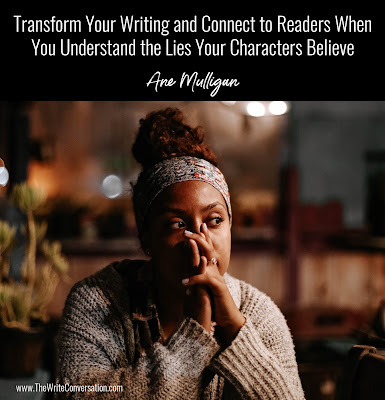
by Ane Mulligan @AneMulligan
Last month, I talked about Core Motivations and how they work with the lie your character believes. Several years ago, my writing was transformed when I learned about the lies our characters believe. Fellow author Amy Wallace studied psychology in college and passed on the informatin to me. Most people believe a lie. It stems in our childhoods and are embedded within us, before we can reason it away.
Let's say your character is a girl. Her father wanted a boy and let her know it. When she was little, he tried to make her play sports, but all she wanted was to play with her dolls. She begged to take ballet lessons instead of playing soccer. Daily, her daddy told how disappointed he was in her. And she believed him. As she grew, this lie colored her worldview. Now, she's tentative/fearful about trying anything new, because she'll disappoint people.
Whichever lie the character's backstory reveals, that helps dictate their motivation. You can use the lie to help plot, since a character's motivation will affect their worldview and everything they do.
Let's say your character's lie is I'm not good enough. He will spend his life either trying to prove it wrong, or he'll fall victim to the lie. This is a great lie for first responders, FBI agents, police, etc. If our hero is one who tries to prove this lie is wrong, he will be the first one to enter a burning building to rescue a pet. He's the first one to charge through enemy lines. Do you see how you can plot by the motivation?
With these lies, there are characteristics you will see in people. Here is the list of the 8 basic lies and their characteristics. You can vary somewhat if you need to fit one into your story. Then tie those into last month's Core Motivations (June 22nd) and you'll have three-dimensional characters your readers will love.
Writing Adult Characteristics of the Lie:
1. I’m a disappointment: S/he wouldn’t be very open to trying new things. After all, they disappoint themselves and others. S/he tends to get stuck in a rut that is familiar. This could be great conflict if they were suddenly thrust into a situation where they had to do something new.
2. Not good enough: This is a very strong lie, often used for men and strong female leads. S/he either lives their life trying to always prove they are good enough. Or, s/he falls victim to their lie and give up. It the latter, this character wouldn’t be the one vying for a promotion or volunteering to go on a dangerous mission.
3. I’m not enough or defective: Her/his actions might be similar to the one who’s a disappointment but from a different angle. Depending on their backstory, s/he feel very unworthy. S/he might have been much loved, but if s/he has other siblings, s/he may compare themselves with them. If s/he’s a middle child, this is a good lie, because when #3 child came along, if it were during those first 5 years, s/he would believe s/he wasn’t enough for their parents. They had to try for another. The first-born could easily feel this too.
4. Too much to handle and will get rejected: this lie plays out a lot in romances. Someone who believes this lie won’t let themselves get close in a romantic situation. If they begin to feel love, they break up to avoid getting rejected. The hurt isn’t worth the risk.
5. It’s all my fault: S/he usually strives for respect and validation. They carry a lot of guilt for things they perceive are their fault. They always believe if they had done this or done something differently, the end result would not have been the disaster it is.
6. Helpless—powerless to fix things: This lie leads to a fear of being controlled. S/he avoids confrontation & problems. S/he wants to be in control of life and all that surrounds her. S/he can be bossy & attempt to wrestle control from others. S/he fears being controlled & this provides super conflict for both inner and outer journeys. S/he’s afraid God’s will is exactly the opposite of what they want. S/he fights against what s/he perceives as someone else wanting to control her/his life, whether it’s the opposite sex or God.
7. Unwanted/unloved: This character might seek love in “all the wrong places” from all the wrong people. Or they might shy away from a romantic situation because they know they’re unlovable. This would affect their relationship with God, too. This character, while having some of the “not good enough” symptoms, isn’t as strong a character as one with that lie. This character might always stay in the background. For instance, if they were part of a community theater, they’d be the one to work backstage, sew costumes, but never try out for a part. They avoid center stage.
8. I’m bad: Which could possibly be used as a symptom or excuse for another lie. This lie is seen often in YA books for a character who will make a 180 degree turn around. They project their self-image to the world as protection for their hearts. Remembering that the lie is embedded in early childhood, they’re hurt and don’t want to be hurt again. So they put up a wall of “badness” to keep people away and keep their vulnerability hidden.
What lie does your character believe? How has knowing that helped move your story forward?
TWEETABLETransform Your Writing and Connect to Readers When You Understand the Lies Your Characters Believe from @AneMulligan on @EdieMelson (Click to Tweet)
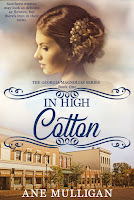 In High Cotton Aug 3 2020Southern women may look as delicate as flowers, but there’s iron in their veins.
In High Cotton Aug 3 2020Southern women may look as delicate as flowers, but there’s iron in their veins.While the rest of the world has been roaring through the 1920s, times are hardscrabble in rural South Georgia. Widow Maggie Parker is barely surviving while raising her young son alone. Then as banks begin to fail, her father-in-law threatens to take her son and sell off her livelihood—the grocery store her husband left her. Can five Southern women band together, using their wisdom and wiles to stop him and survive the Great Depression?
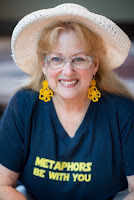 Ane Mulligan has been a voracious reader ever since her mom instilled within her a love of reading at age three, escaping into worlds otherwise unknown. But when Ane saw Mary Martin in PETER PAN, she was struck with a fever from which she never recovered—stage fever. She submerged herself in drama through high school and college. Years later, her two loves collided, and a bestselling, award-winning novelist emerged. She resides in Sugar Hill, GA, with her artist husband and a rascally Rottweiler. Find Ane on her website, Amazon Author page, Facebook, Twitter, Instagram, Pinterest and The Write Conversation.
Ane Mulligan has been a voracious reader ever since her mom instilled within her a love of reading at age three, escaping into worlds otherwise unknown. But when Ane saw Mary Martin in PETER PAN, she was struck with a fever from which she never recovered—stage fever. She submerged herself in drama through high school and college. Years later, her two loves collided, and a bestselling, award-winning novelist emerged. She resides in Sugar Hill, GA, with her artist husband and a rascally Rottweiler. Find Ane on her website, Amazon Author page, Facebook, Twitter, Instagram, Pinterest and The Write Conversation. Featured Image: Photo by kevin turcios on Unsplash
Published on July 28, 2023 22:00
July 27, 2023
8 Amazing Gifts for Writers

By Lori Hatcher @LoriHatcher2
I love my writer friends. They understand the agonies of proposals, edits, and book launches. They pray for me in the middle of the night when they know I’m fast approaching a hard deadline or suffering from writer’s block. They also share my hatred for comma splices and my love for a well-turned phrase.
When things get tough, my writer friends send presents. When I complete my manuscript or launch a book, they send me presents. Sometimes, just because they love me, they send me presents.
And not just any present. WRITER presents. Clever, funny, practical presents.
I hope you have at least one special writer friend. One who really gets you. If so, why not write them a note (see what I did there?) or a text. Better yet, send them a note AND a present.
Here Are My Favorite Presents for Writers (with links):
Chick-Fil-A Milkshake My go-to celebration writer present is a Chick-Fil-A gift card with enough cash on it to buy a milkshake. This gift is suitable for happy days and sad ones. You can slide it into a card, stick a stamp on it, and whoosh it out the door. I keep a few on hand so I don’t even have to leave the house to do something thoughtful. Nothing says “I love you” like a CFA milkshake.
Vintage Typewriter Pencil Holder One Christmas, my soon-to-be-famous writer friend Jean Wilund gave me the cutest miniature vintage typewriter. Made of cast metal with teeny tiny white keys and a well for pens and pens, it sits atop my writing desk and makes me smile.
The Best Pens EVER Hands down, Papermate InkJoy gel pens are the best pens for critiquing (they come in purple, green, and teal, not just red) or for signing those thousands of author copies. They write smoothly, dry quickly, and fit nicely in your hand. The 0.7 fine point is perfect for making notes in the margin of your Bible. My soon-to-be-published friend Jeannie Waters sent me a set recently—just because.
Bookmarks Are for Quitters T-shirtNo one needs another t-shirt—unless it’s this one. As a tribute to the many all-night reading sessions when you just couldn’t put that incredible book down, this writerly t-shirt is perfect to wear at conferences, Word Weavers meetings, or on rainy days when you just want to curl up and read a good book.
Grammar Pencils Last month, my hubby and I were tooling around Black Mountain and discovered a bookstore that sold writerly things. When I spotted a set of ten pencils with phrases stamped on them like There, Their, There; Who, Which, and Their, There, and They’re, I knew I had to buy them for my illustriously brilliant agent, Bob Hostetler . A grammar nerd like I am, He won my heart with his defense of the Oxford comma. I knew this would be a good way to share a little author/agent love.
Limited Edition Color Post-It Notes Is there anyone who doesn’t love sticky notes? Writers use them to capture ideas, remind ourselves of deadlines and can’t-forgets, and help us visualize chapters, characters, and simultaneous plot lines. I once write an entire devotion in 6-point print on a sticky note because it was the only paper available. If you want to send a writer friend over the sticky note rainbow, send her this set that contains 15 pads with 45 sheets per pad. Six hundred and seventy-five glorious sticky notes!
I Before E Mug No list of writer gifts is complete without at least one coffee mug. After all, writers turn coffee into books, right? This one celebrates the maddening nuances of our English: I before E except after C except when you heinously seize your feisty foreign neighbor’s conceited beige heifer from the ceiling.
Ferrero Rocher Premium Gourmet Milk Chocolate Hazelnut Candy Need to curry favor with (or grovel before) an editor, agent, podcaster, or writer? Try this gift. If twenty-four gold-foil-wrapped hazelnut chocolates don’t smooth the waters around you, there’s no hope. I once sent this gift to an editor to apologize for quoting Bible verses from memory instead of cutting and pasting, thus creating a lot of extra work for her and (apparently) a new Bible translation called Hatchelonians. Mea culpa!
I hope this fun post has inspired you to celebrate and thank the writers in your life. Now it’s your turn. Leave a comment below and share your favorite writer gift to give or receive.
TWEETABLE
8 Amazing Gifts for Writers from author @LoriHatcher2 on @EdieMelson (Click to Tweet)
 Lori Hatcher is an author, blogger, writing instructor, women’s ministry speaker, and career dental hygienist. She writes for Our Daily Bread, Guideposts, Revive Our Hearts, and Crosswalk.com. Check out her latest devotional, REFRESH YOUR HOPE, 60 DEVOTIONS FOR TRUSTING GOD WITH ALL YOUR HEART from Our Daily Bread Publishing. Connect with her at WWW.LORIHATCHER.COM or on FACEBOOK, TWITTER (@lorihatcher2) or PINTEREST(Hungry for God).
Lori Hatcher is an author, blogger, writing instructor, women’s ministry speaker, and career dental hygienist. She writes for Our Daily Bread, Guideposts, Revive Our Hearts, and Crosswalk.com. Check out her latest devotional, REFRESH YOUR HOPE, 60 DEVOTIONS FOR TRUSTING GOD WITH ALL YOUR HEART from Our Daily Bread Publishing. Connect with her at WWW.LORIHATCHER.COM or on FACEBOOK, TWITTER (@lorihatcher2) or PINTEREST(Hungry for God).Featured Image: Photo by Towfiqu barbhuiya on Unsplash
Published on July 27, 2023 22:00
July 26, 2023
Common Writing Obstacles: Building Believable Characters (Part 8)
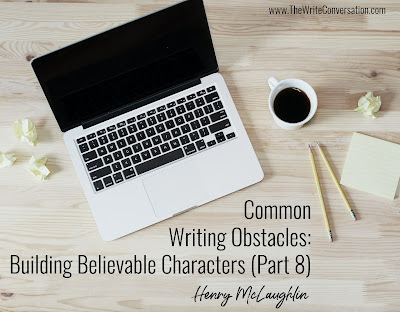
by Henry McLaughlin @RiverBendSagas
This is the latest in a periodic series about the common obstacles writers face. Both experienced and newbie authors deal with building characters who are believable and real enough for the reader to want to follow for several hundred pages.
For some writers, this can be the most challenging obstacle to overcome. How do we make our characters real? How do we make a figment of our imagination complete enough to engage the reader? To keep the reader interested enough to stick with character on his or her journey? How do we avoid cliches, stereotypes, and making our character sound like everyone else in our genre?
This is one of those areas where we need to involve both the left and right sides of our brain; the analytical and the creative. The creative should dominate the process, but the analytical will help us to not wander too far into the weeds.
A character is most often the impetus for my story. He or she will appear in my mind and arouse my curiosity. He’ll show up in a situation. Sometimes it’s vivid action. Sometimes it seems almost contemplative. But the situation stimulates me to ask questions: Why is she there? Who is she? What is he doing? What does he want? And we’re off on what I like to call a journey of serendipitous discovery.
There is what feels like tons of information and resources for building characters. Some focus on questionnaires to determine character traits. Other focus on physical descriptions. Others deal with the psychological aspects of the character. Many are helpful and require due diligence on the author’s part to discover what works best for them.
In my early years of writing, I tried various personality traits and tools like Meyers Briggs and detailed character questionnaires. I found I spent a lot of time gathering information I never used, or, because I had all this material, I tried to force the information into the story when it wasn’t pertinent or even necessary.
My initial meeting with my characters reveals some basic characteristics: age range, gender, basic physical appearance. After that, what I have found most helpful is to let the character reveal the depths of who he or she is to me by releasing them to tell me their story.
Ray Bradbury wrote, “First, find out what your hero wants, then just follow him!”
William Faulkner told a group of students, “Get the character in your mind. Once he is in your mind, and he is right, and he’s true, then he does the work himself. All you need to do then is to trot along behind him and put down what he does and what he says.”
And I let the character tell me the story. In multiple point of view stories, I discover more depth and meaning in the plot and overall story and character arcs. In the characters telling, I discover their vital elements in their backstory, their personality traits, what drives them and what hinders them. These come out when the information is necessary and relevant to the story.
I once thought one of my characters was being stubborn in not revealing more of herself. So, I interviewed her (which is a great technique, by the way). At one point I asked, “Rachel, I don’t get you. What do you want?”
She did one of her fabulous eye rolls, sighed, and said, “Don’t you get it? Have you even read the book?”
At that moment, she clicked for me. What I was missing was her feisty independence. Men had dominated and used and abused her. No man was ever going to dominate her again. We’ve since become great friends. She is one of my favorite characters, even when she nags me to write another book.
How do you develop your characters? What have you found helpful in making your characters believable?
TWEETABLECommon Writing Obstacles: Building Believable Characters from author Henry McLaughlin (@RiverBendSagas) on @EdieMelson (Click to Tweet)
Don't Miss the Rest of the Posts in This Series!COMMON WRITING OBSTACLES (PART 1): TIMECOMMON WRITING OBSTACLES (PART 2): TALENT VS LEARNINGCOMMON WRITING OBSTACLES (PART 3): PERFECTIONISMCOMMON WRITING OBSTACLES (PART 4): WORLD BUILDINGCOMMON WRITING OBSTACLES (PART 5): TAKING RISKSCOMMON WRITING OBSTACLES (PART 6): PLOTTINGCOMMON WRITING OBSTACLES (PART 7): TAKING RISKSCOMMON WRITING OBSTACLES (PART 8): BUILDING BELIEVABLE CHARACTERS
Links to The Art of Self-Editing Blogs:THE ART OF SELF EDITING PART 1THE ART OF SELF-EDITING, PART 2THE ART OF SELF-EDITING, PART 3THE ART OF SELF-EDITING, PART 4THE ART OF SELF-EDITING, PART 5
 Henry’s debut novel, Journey to Riverbend, won the 2009 Operation First Novel contest.
Henry’s debut novel, Journey to Riverbend, won the 2009 Operation First Novel contest.Henry edits novels, leads critique groups, and teaches at conferences and workshops. He enjoys mentoring and coaching individual writers.
Connect with Henry on his BLOG, TWITTER and FACEBOOK.
Featured Image: Photo by Lauren Mancke on Unsplash
Published on July 26, 2023 22:00
July 25, 2023
10 Tips to Help You Write a Character Who's Your Exact Opposite
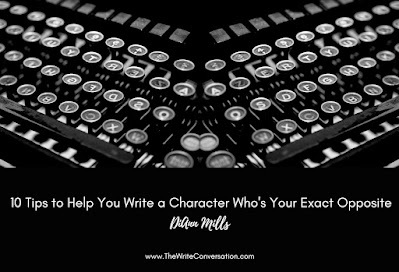
by DiAnn Mills @DiAnnMills
One of the challenges of creating memorable characters is to choose traits opposite to our own. We know how we react and respond in various situations, making the story easier to craft. But that doesn’t mean we have produced the best character. Writing what we know is an excellent choice when we are sharpening our tools—practicing for publication. The process helps us develop our voice, learn fiction writing techniques, walk through critiques, and add to our training of establishing ourselves as a writer.
When we’ve practiced and perfected our writing muscles, the time comes to stretch and expand our stories. How do we think outside the box to treat our readers to the unusual, quirky, loveable, and sometimes detestable?
10 Ways to Power-pack the Characters You Write with Unique Traits
1. Understand your personality. Thoroughly. Detailed. Inside and out. If necessary, use one of the various personality tests to determine your dominant traits. We all have quirks, ideas, opinions, and beliefs that don’t fall under a specific personality. That makes us unique just like we want our characters to stand out.
2. Determine the career path of the character. Would the profession be something you haven’t or wouldn’t consider? What is required to obtain the career? Education? Skills? Lifestyle? Where is the character on their career path?
3. Establish characteristics that are opposite of yours. Can those traits be used effectively in your story? For example, you might prefer an evening reading and listening to music, but the character might thrive on interactions with others.
4. Create a home for the character that is foreign to yours. What style fits your character? Colors? Design?
5. Show the character’s culture. Research is your best friend.
6. Choose the character’s education skills or lack of. Where obtained? How?
7. Develop an unusual backstory that pours into the character’s motivation before chapter one, line one is written.
8. Specify the character’s best friend and friends. Why these characters?
9. Include strong emotion that is unpredictable but true to the character.
10. Study human behavior and observe people active in various activities.
If we write characters that are like us, our stories lose flavor and bore our readers with the same wants, desires, dialogue, personality, flaws, and weaknesses. When we accept the challenge and expand our skills to create characters who journey through unpredictable novels, not only will our readers thank us, but we will be pleased with our effort.
How do you create characters who are opposite of you?
TWEETABLE10 Tips to Help You Write a Character Who's Your Exact Opposite from @DiAnnMills on @EdieMelson (Click to Tweet)
 DiAnn Mills is a bestselling author who believes her readers should expect an adventure. She creates action-packed, suspense-filled novels to thrill readers. Her titles have appeared on the CBA and ECPA bestseller lists; won two Christy Awards; and been finalists for the RITA, Daphne Du Maurier, Inspirational Readers’ Choice, and Carol award contests.
DiAnn Mills is a bestselling author who believes her readers should expect an adventure. She creates action-packed, suspense-filled novels to thrill readers. Her titles have appeared on the CBA and ECPA bestseller lists; won two Christy Awards; and been finalists for the RITA, Daphne Du Maurier, Inspirational Readers’ Choice, and Carol award contests. She is the former director of the Blue Ridge Mountain Christian Writers Conference, Mountainside Marketing Retreat, and Mountainside Novelist Retreat with social media specialist Edie Melson. Connect here: DiAnnMills.com
Published on July 25, 2023 22:00
July 24, 2023
Dipping the Quill Deeper: Moving On as a Writer
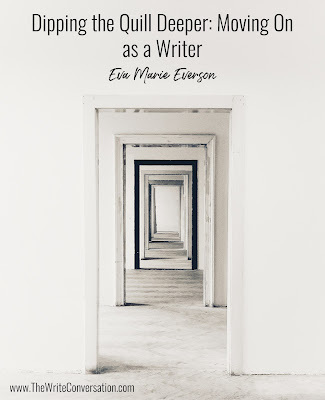
by Eva Marie Everson @EversonAuthor
“How did you break into publishing?”
I hear this question mostly at conferences but sometimes during interviews.
My answer is simple: God opened doors and I walked through them.
I admit to having never attended writers conferences, one after the other, hoping for a break. I admit that I stumbled into a world I previously knew little about. I admit to the Cinderella story—I attended a fancy ball (a convention), left a glass slipper behind (a book proposal), and nine days later “the prince” called to see if the shoe fit.
It did. That one door opened, and I walked from outside the palace to its marble-floored foyer.
In Ancient Days
Approximately 1440 years before the birth of Christ, Moses led the Hebrew slaves out of Egypt toward the Promised Land. They’d prayed angst-driven prayers toward the desire to live elsewhere, under their “own authority” rather than Pharoah’s. But getting from Point A to Point B didn’t come easily. In fact, along the way, those who previously begged God for deliverance now begged Moses to “send us back.” They wanted freedom, but the price to get it was not something they’d counted on.
In the 14th chapter of Exodus, we read the following:
They said to Moses, “Was it because there were no graves in Egypt that you brought us to the desert to die? What have you done to us by bringing us out of Egypt? Didn’t we say to you in Egypt, ‘Leave us alone; let us serve the Egyptians’? It would have been better for us to serve the Egyptians than to die in the desert!”
Moses answered the people, “Do not be afraid. Stand firm and you will see the deliverance the Lord will bring you today. The Egyptians you see today you will never see again. The Lord will fight for you; you need only to be still.”
Then the Lord said to Moses, “Why are you crying out to me? Tell the Israelites to move on.”
Is There a Conflict Here?
Does this seem like a contradiction to you? Moses tells the people to “be still” and the Lord tells them to “move on.”
And what, pray tell, does this have to do with writing . . . or publishing?
Be still and I’ll tell you.
There are times within our work as writers and as published authors—if that is the way you wish to go—when we need to be still (the Hebrew word denotes a sense of peace). We are ready to plow the row, but God sees gnarled roots ahead. His desire for you is to move along in the field a ways because there is a row where the soil has already been made ready, This is the place where your labor will yield an abundant crop.
When Moses cried out to God, God asked, “Why are you crying out to me? Get moving! Raise that staff I told you to hold on to back there on Mount Horeb and then watch what I do” (Exodus 14:15,16 paraphrased).
There are times when we need to raise the tool of our trade (for Moses, a staff . . . for us, a pen) and walk between the waters of the sea. Or, sticking with the Cinderella story, the next door. The glass-slippered princess didn’t stay in the foyer of the palace, I’m sure. She saw a staircase and climbed it, another opened door and she walked through it and on and on.
But It May Not Always Be Easy
Getting from the attic to the palace wasn’t always easy for Cinderella. Getting from Egypt to the Promised Land wasn’t easy for the Hebrew ex-slaves. But they walked on. They kept going. Their best bet was always, however, to only walk through those doors (and seas) opened (or parted) by God.
Look at some of the bestselling books within our industry and you’ll note that they, so many of them, were born out of tragedy, hardship, or a reckoning with God. Even works of fiction have the same beginning—something intense happened which led to a need to “tell a story.”
Our God is Bigger Than That!, a children’s book I co-wrote with Michelle Medlock Adams had its beginnings in a hospital corridor where fear reared its ugly head. Dust, my latest published novel, was birthed as I sat at my desk considering my life and the decision I’d made. I penned The Third Path, a work on nonfiction, as I struggled with questions I had for God, but moreso on the questions He had for me.
Trust God on These
Whatever you’re working on, I encourage you to trust God for those times of being still (quieted by His peace) and those times of walking on. My prayer for you is the same as the prayer I’ve prayed for myself over the years: Dear Lord, may the works of my hands be a blessing to you. Open the doors you want opened. Close the doors you want shut. And keep my hands off the doorknobs.
Walk on.
TWEETABLEDipping the Quill Deeper: Moving On as a Writer from author @EversonAuthor on @EdieMelson (Click to Tweet)
 Eva Marie Everson is the CEO of Word Weavers International, the director of Florida Christian Writers Conference, and the contest director for Blue Ridge Mountains Christian Writers Conference. She is the multiple award-winning author of more than 40 books and countless articles and blogposts. She is also an award-winning speaker and a Bible teacher and the most recent recipient of the AWSA Lifetime Achievement Award (2022).
Eva Marie Everson is the CEO of Word Weavers International, the director of Florida Christian Writers Conference, and the contest director for Blue Ridge Mountains Christian Writers Conference. She is the multiple award-winning author of more than 40 books and countless articles and blogposts. She is also an award-winning speaker and a Bible teacher and the most recent recipient of the AWSA Lifetime Achievement Award (2022). Eva Marie is often seen at writers conferences across the States. She served as a mentor for the Jerry B. Jenkins Christian Writers Guild and taught as a guest professor at Taylor University in 2011. She and her husband make their home in Central Florida where they enjoy their grandchildren. They are owned by one persnickety cat named Vanessa.
Eva Marie's latest book, THE THIRD PATH, takes a look at 26 of the questions God asked in the Bible, then makes them personal to the reader. The premise of the book is currently her most asked for continuing workshop at writers conferences.
Featured Image: Photo by Filip Kominik on Unsplash
Published on July 24, 2023 22:00



